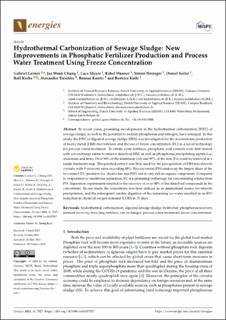Please use this identifier to cite or link to this item:
https://doi.org/10.21256/zhaw-28990Full metadata record
| DC Field | Value | Language |
|---|---|---|
| dc.contributor.author | Gerner, Gabriel | - |
| dc.contributor.author | Chung, Jae Wook | - |
| dc.contributor.author | Meyer, Luca | - |
| dc.contributor.author | Wanner, Rahel | - |
| dc.contributor.author | Heiniger, Simon | - |
| dc.contributor.author | Seiler, Daniel | - |
| dc.contributor.author | Krebs, Rolf | - |
| dc.contributor.author | Treichler, Alexander | - |
| dc.contributor.author | Kontic, Roman | - |
| dc.contributor.author | Kulli Honauer, Beatrice | - |
| dc.date.accessioned | 2023-10-27T13:58:08Z | - |
| dc.date.available | 2023-10-27T13:58:08Z | - |
| dc.date.issued | 2023 | - |
| dc.identifier.issn | 1996-1073 | de_CH |
| dc.identifier.uri | https://digitalcollection.zhaw.ch/handle/11475/28990 | - |
| dc.description.abstract | In recent years, promising developments in the hydrothermal carbonization (HTC) of sewage sludge, as well as the potential to reclaim phosphorus and nitrogen, have emerged. In this study, the HTC of digested sewage sludge (DSS) was investigated for the downstream production of heavy metal (HM)-free fertilizer and the use of freeze concentration (FC) as a novel technology for process water treatment. To obtain clean fertilizer, phosphatic acid extracts were first treated with ion-exchange resins to remove dissolved HM, as well as phosphorus precipitating agents (i.e., aluminum and iron). Over 98% of the aluminum (Al) and 97% of the iron (Fe) could be removed in a single treatment step. The purified extract was then used for the precipitation of HM-free struvite crystals, with P-recovery rates exceeding 89%. Process water (PW) makes up the largest share of the two main HTC-products (i.e., hydrochar and PW) and is very rich in organic compounds. Compared to evaporation or membrane separation, FC is a promising technology for concentrating solutes from PW. Separation experiments resulted in the recovery of over 90% of the dissolved compounds in the concentrate. In our study, the concentrate was later utilized as an ammonium source for struvite precipitation, and the subsequent aerobic digestion of the remaining ice water resulted in an 85% reduction in chemical oxygen demand (COD) in 15 days. | de_CH |
| dc.language.iso | en | de_CH |
| dc.publisher | MDPI | de_CH |
| dc.relation.ispartof | Energies | de_CH |
| dc.rights | http://creativecommons.org/licenses/by/4.0/ | de_CH |
| dc.subject | Hydrothermal carbonization | de_CH |
| dc.subject | Sewage sludge | de_CH |
| dc.subject | Process water treatment | de_CH |
| dc.subject | Fertilizer production | de_CH |
| dc.subject | Düngerherstellung | de_CH |
| dc.subject | Prozesswasserbehandlung | de_CH |
| dc.subject | Hydrothermale Karbonisierung | de_CH |
| dc.subject | Klärschlamm | de_CH |
| dc.subject.ddc | 660: Technische Chemie | de_CH |
| dc.title | Hydrothermal carbonization of sewage sludge : new improvements in phosphatic fertilizer production and process water treatment using freeze concentration | de_CH |
| dc.type | Beitrag in wissenschaftlicher Zeitschrift | de_CH |
| dcterms.type | Text | de_CH |
| zhaw.departement | Life Sciences und Facility Management | de_CH |
| zhaw.organisationalunit | Institut für Chemie und Biotechnologie (ICBT) | de_CH |
| zhaw.organisationalunit | Institut für Umwelt und Natürliche Ressourcen (IUNR) | de_CH |
| dc.identifier.doi | 10.3390/en16207027 | de_CH |
| dc.identifier.doi | 10.21256/zhaw-28990 | - |
| zhaw.funding.eu | No | de_CH |
| zhaw.issue | 20 | de_CH |
| zhaw.originated.zhaw | Yes | de_CH |
| zhaw.pages.start | 7027 | de_CH |
| zhaw.publication.status | publishedVersion | de_CH |
| zhaw.volume | 16 | de_CH |
| zhaw.publication.review | Peer review (Publikation) | de_CH |
| zhaw.webfeed | Bodenökologie | de_CH |
| zhaw.webfeed | Umweltbiotechnologie und Bioenergie | de_CH |
| zhaw.author.additional | No | de_CH |
| zhaw.display.portrait | Yes | de_CH |
| zhaw.monitoring.costperiod | 2023 | de_CH |
| Appears in collections: | Publikationen Life Sciences und Facility Management | |
Files in This Item:
| File | Description | Size | Format | |
|---|---|---|---|---|
| 2023_Gerner-etal_Hydrothermal-carbonization-of-sewage-sludge-new-improvements_energies.pdf | 13.28 MB | Adobe PDF |  View/Open |
Show simple item record
Gerner, G., Chung, J. W., Meyer, L., Wanner, R., Heiniger, S., Seiler, D., Krebs, R., Treichler, A., Kontic, R., & Kulli Honauer, B. (2023). Hydrothermal carbonization of sewage sludge : new improvements in phosphatic fertilizer production and process water treatment using freeze concentration. Energies, 16(20), 7027. https://doi.org/10.3390/en16207027
Gerner, G. et al. (2023) ‘Hydrothermal carbonization of sewage sludge : new improvements in phosphatic fertilizer production and process water treatment using freeze concentration’, Energies, 16(20), p. 7027. Available at: https://doi.org/10.3390/en16207027.
G. Gerner et al., “Hydrothermal carbonization of sewage sludge : new improvements in phosphatic fertilizer production and process water treatment using freeze concentration,” Energies, vol. 16, no. 20, p. 7027, 2023, doi: 10.3390/en16207027.
GERNER, Gabriel, Jae Wook CHUNG, Luca MEYER, Rahel WANNER, Simon HEINIGER, Daniel SEILER, Rolf KREBS, Alexander TREICHLER, Roman KONTIC und Beatrice KULLI HONAUER, 2023. Hydrothermal carbonization of sewage sludge : new improvements in phosphatic fertilizer production and process water treatment using freeze concentration. Energies. 2023. Bd. 16, Nr. 20, S. 7027. DOI 10.3390/en16207027
Gerner, Gabriel, Jae Wook Chung, Luca Meyer, Rahel Wanner, Simon Heiniger, Daniel Seiler, Rolf Krebs, Alexander Treichler, Roman Kontic, and Beatrice Kulli Honauer. 2023. “Hydrothermal Carbonization of Sewage Sludge : New Improvements in Phosphatic Fertilizer Production and Process Water Treatment Using Freeze Concentration.” Energies 16 (20): 7027. https://doi.org/10.3390/en16207027.
Gerner, Gabriel, et al. “Hydrothermal Carbonization of Sewage Sludge : New Improvements in Phosphatic Fertilizer Production and Process Water Treatment Using Freeze Concentration.” Energies, vol. 16, no. 20, 2023, p. 7027, https://doi.org/10.3390/en16207027.
Items in DSpace are protected by copyright, with all rights reserved, unless otherwise indicated.